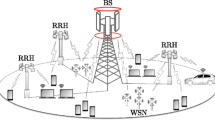Abstract
This paper presents an effective alternating multiuser detector for the uplink of heterogeneous-signaling multiple-input multiple-output code division multiple access systems over multipath fading channels, where the data are transmitted using either spatially multiplexing for high transmission rate or space-time block code for transmit diversity gains. The new MUD first separates users into two groups according to their transmission signaling schemes and then detects the transmitted symbols in each group alternately with the removal of iteratively refined soft information-assisted multiple access interference to enhance the interference cancellation capability. Moreover, for practical low-complexity implementations, the users in each group are further partitioned into smaller subgroups based on their effective channel correlations and then detected in parallel by a bank of minimum mean-squared error soft detectors to further reduce the computational load. Conducted simulations show that the proposed MUD can render superior performance compared with previous approaches, especially in highly loaded scenarios.
Similar content being viewed by others
References
Holma H., Toskala A. (2002) WCDMA for UMTS-Radio access for third generation mobile communications. Wiley, New York
Huang H., Viswanathan H., Foschini G. J. (2002) Multiple antennas in cellar CDMA systems: Transmission, detection, and spectral efficiency. IEEE Transactions on Wireless Communications 1(3): 383–392
Foschini G. J., Golden G. D., Valenzuela R. A., Wolniansky P. W. (1999) Simplified processing for high spectral efficiency wireless communication employing multi-element arrays. IEEE Journal on Selected Areas in Communications 17(11): 1841–1852
Alamouti S. (1998) A simple transmit diversity scheme for wireless communications. IEEE Journal on Selected Areas in Communications 16(8): 1451–1458
Paulraj A., Nabar R., Gore D. (2003) Introduction to space-time wireless communications. Cambridge University press, Cambridge
Zheng L., Tse D. (2003) Diversity and multiplexing: A foundamental tradeoff in multiple antenna channel. IEEE Transactions on Information Theory 49(5): 1073–1096
Paulraj A. J., Gore D. A., Nabar R. U., Bölcskei H. (2004) An overview of MIMO communications—A key to gigabit wireless. Proceedings of the IEEE 92(2): 198–218
Ho C.-L., Wu J. Y., Lee T.-S. (2006) Group-wise V-BLAST detection in multiuser space-time dual-signaling wireless systems. IEEE Transactions on Wireless Communications 5(7): 1896–1909
Dai L., Sfar S., Letaief K. B. (2005) An efficient detector for combined space-time coding and layered processing. IEEE Transactions on Communications 53(9): 1438–1442
Li Z., Latva-Aho M. (2006) Nonblind and semiblind space-frequency multiuser detection for multirate MC-CDMA systems. IEEE Transactions on Signal Processing 54: 4393–4404
Pelletier B., Champagne B. (2007) Group-based space-time multiuser detection with user sharing. IEEE Transactions on Wireless Communications 6(6): 2034–2039
Sfar S., Murch R. D., Letaief K. B. (2003) Layered space-time multiuser detection over wireless uplink systems. IEEE Transactions on Wireless Communications 2(4): 653–668
Golkar, B., & Danilo-Lemoine, F. (2007). Space-Time coding and spatial multiplexing in MIMO multicarrier CDMA. In Proceedings of IEEE 18th international symposium on personal, indoor and mobile radio communications, (pp. 1–5).
Verd u S. (1998) Multiuser detection. Cambridge University Press, Cambridge
Waters D. W., Barry J. R. (2008) The Chase family of detection algorithms for multiple-input multiple-output channels. IEEE Transactions on Signal Processing 56(2): 739–747
Feng, L., & Soleymani, M. R. (2007). A novel Chase based multiuser detector for MIMO-CDMA Systems. In Proceedings of IEEE Vehicular Technology Conference (pp. 975–979).
Lee K., Chun J. (2007) Symbol detection in V-BLAST architectures under channel esimation errors. IEEE Transactions on Wireless Communications 6(2): 593–597
Wang X., Poor H. V. (1999) Iterative (Turbo) soft interference cancellation and decoding for coded CDMA. IEEE Transactions on Communications 47(7): 1045–1061
Tran X. N., Ho H. C., Fujino T., Karasawa Y. (2008) Performance comparison of detection methods for combined STBC and SM systems. IEICE Transactions on Communications E91-B(6): 1734–1742
Zhang Y. J., Letaief K. B. (2005) An efficient resource-allocation scheme for spatial multiuser access in MIMO/OFDM systems. IEEE Transactions on Communications 53(1): 107–116
Heath R. W. Jr., Paulraj A. J. (2005) Switching between diversity and multiplexing in MIMO systems. IEEE Transactions on Communications 3(6): 962–968
Lu H.-Y., Fang W.-H. (2009) Soft information assisted space-time multiuser detection for highly loaded CDMA. IEEE Transactions on Wireless Communications 8(2): 662–667
Wang X., Poor H. V. (2004) Wireless communication systems. Pearson Education, NJ
Golub G. H., Van Loan C. F. (1996) Matrix computations (3rd ed.). Johns Hopkins University Press, Baltimore
Moon T. K., Stirling W. C. (2000) Mathematical methods and algorithms for signal processing. Prentice Hall, Upper Saddle River
Author information
Authors and Affiliations
Corresponding author
Rights and permissions
About this article
Cite this article
Tu, YP., Lu, HY. & Fang, WH. Alternating Multiuser Detection with Soft Interference Cancellation for Heterogeneous-Signaling MIMO CDMA Systems. Wireless Pers Commun 67, 811–828 (2012). https://doi.org/10.1007/s11277-011-0412-6
Published:
Issue Date:
DOI: https://doi.org/10.1007/s11277-011-0412-6




